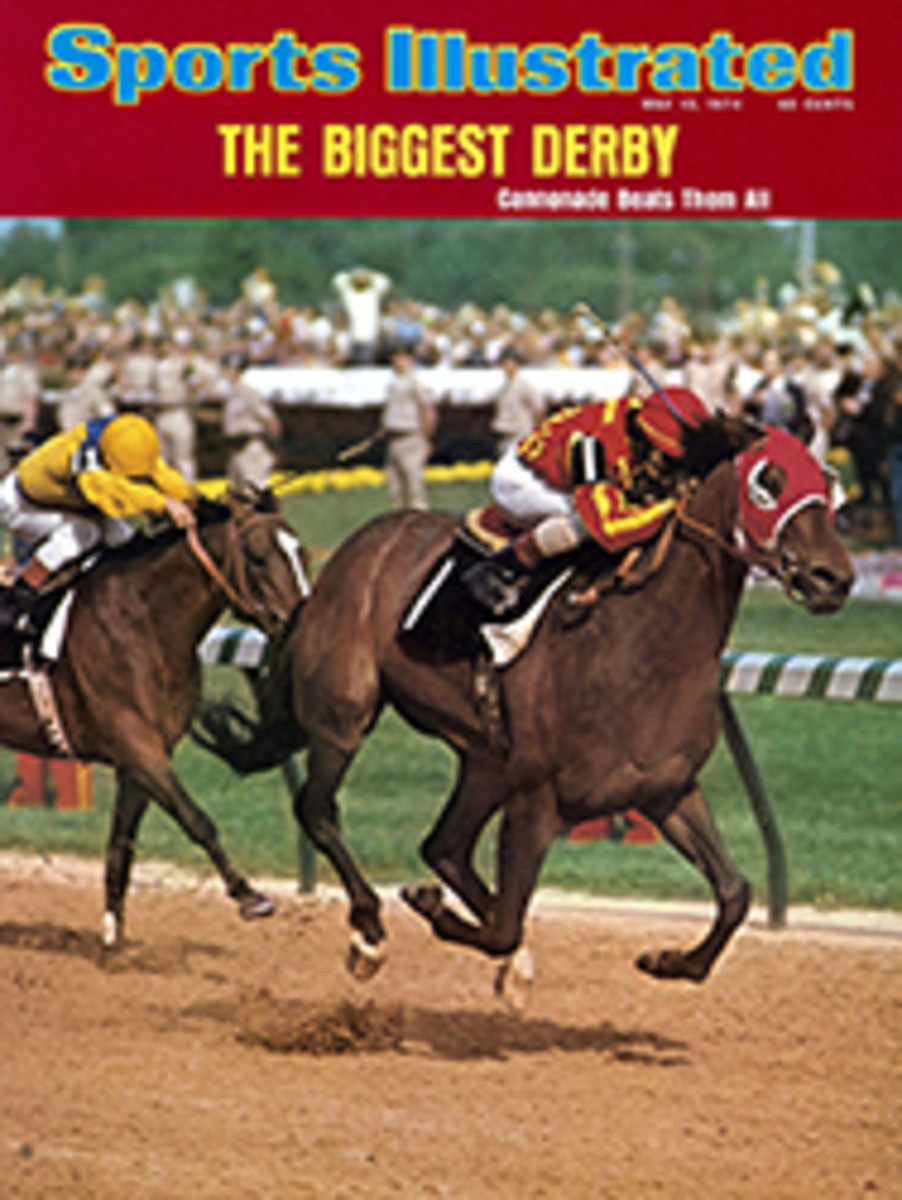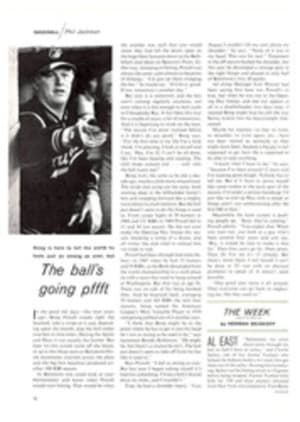
SCORECARD
AMATEURS' HOUR
Any day now the U.S. Senate will take up the subject of amateur athletics and this country's participation in international competition, particularly the Olympics. Sometime later the House will respond with a bill of its own.
Without going into past AAU-NCAA-USOC hassles that unhappily have occupied this country's athletic bodies for over a decade, it is enough to know that the Senate will be considering two bills that will put the government foursquare in amateur sports. One, which the Senate is expected to approve quickly, would establish a commission to review U.S. participation in the Olympic Games and perhaps recommend a new organization to direct it. The other bill, setting up its own Olympic study board, would go much further by creating a five-member Amateur Sports Board that would charter national athletic governing bodies such as the AAU, adjudicate disputes between them and provide recourse to the U.S. courts. The board would also approve organizations to represent the U.S. abroad, designate teams and individuals for international events and conduct domestic competition. Finally, the bill would establish a 16-member Sports Foundation to develop and improve sports facilities. To that end the U.S. would match, to a limit of $50 million, funds raised privately. In both bills the principal members of the boards would be designated by the President.
The House bill, if you can hang with this for one more dose, was introduced by two-time Olympic champion Bob Mathias. It would amend the federal Olympic charter to provide for binding arbitration by the American Arbitration Association, an independent organization, in jurisdictional disputes and in securing a bill of rights for individual athletes.
Since 1964, when the then-Attorney General, Robert F. Kennedy, advocated in these pages a sports-development foundation that would require some federal involvement, we have stated our opposition to the intrusion by government into sport. We see no objection, however, to a study of our sometimes imperfect administrative performance in the Olympics. The United States Olympic Committee says it would welcome that, if for no other reason than to clear its name.
Leading athletes favor the foundation idea with its promise of $100 million for facilities, but in a country of this size $100 million would prove little more than a chimera, and the government would have a foothold. It would have almost a stranglehold on amateur sport if the Amateur Sports Board were enacted into law and the President were given the right to select amateur sports leaders. A more broadly representative USOC that, from time to time, is subject to outside investigation is preferable, in our view, to total governmental control, as practiced by an increasing number of nations.
The brightest idea, and one we would like to see enacted, is Mathias' for compulsory arbitration through the nongovernmental AAA. It just could succeed at last in knocking some sense into AAU and NCAA heads.
POLARIZATION
After years of trying to reconcile the English golf ball and the U.S. version, the United States Golf Association has decided that the two are poles apart, which is not the case in Australia, where the problem is finding the poles apart. But this needs telling.
First, the USGA announced last month that it was withdrawing from the attempt to achieve a compromise ball with the Royal and Ancient Golf Club of St. Andrews. In England and most of the rest of the world they play a ball that measures 1.62 inches in diameter. The U.S. ball is 1.68 and the hope was that the only two rules-making bodies in golf—which have no other differences—could get together on 1.66. This is not to be, the USGA says, because of the expense involved in studying and learning to control the distance characteristics of the new ball and retooling to produce it.
As to those poles in the Antipodes, Milford-Aster Pty. Ltd., a Down Under manufacturer of machinery that brands golf balls with trade names, prides itself on its operators who have succeeded in what can best be described as an arcane art. Milford-Aster claims that in order to make a proper impression on the balls with their electronic, pneumatic devices, its people have learned to distinguish one dimple at the top from another dimple at the bottom (the poles) and a band in the middle that is without dimples (the equator). Wham! They insert the balls at the precise angle and out come the names, printed between dimples, yet. It is all very mysterious and, like the game itself, humblin'.
RANK PRANK
Poker players know there is no percentage in trying to bluff a naive opponent. The cleverer the ruse the greater the certainty that Mr. Unobservant will bet blindly into sure disaster—and win the pot. But, holy smokes, some would-be April Fool pranksters should have expected more of a rise out of the people of Sitka, Alaska. With great care and planning, they soaked 70 old truck tires in kerosene and chartered a helicopter to transport them to the summit of Mount Edgecumbe, an extinct volcano cone 13 miles out of town, which had not erupted in four centuries. On their last trip—it took six hours of flying at $150 an hour—they dropped a flaming torch, and then wheeled for town and the fun. A fine pillar of smoke rose menacingly—and not a soul noticed it. If you are ever in Sitka, don't play poker.
20TH CENTURY LIMITED
The words were quaint, as well they might have been, considering the thought they conveyed. Last week, in a temporary injunction prohibiting the World Football League from signing any Dallas Cowboy, Texas District Court Judge Charles Long said, "It is to be regretted that physical ability, a God-given physique and a proper application of wonderful physical attributes have finally become a matter of barter, purchase and sale, if you please." Next Judge Long is going to tell us that people have been making money out of this sort of thing, if you please.
OH, CHARLIE
In 1963 Charles O. Finley said, "If a manager of mine ever said someone was indispensable, I'd fire him." This season there is more missing from Oakland Coliseum than dispensable managers. The stadium bunting, for instance. It is gone, along with the fireworks that used to salute A's homers. Half-price-ticket nights have been cut from every home Monday to four dates; fans no longer receive 25% discounts on season tickets; and those longtime crowd pleasers, ball girls Mary Barry and Debbie Sivyer, have joined 10 ex-managers and a phalanx of ballplayers in C.O.F.'s rapidly expanding alumni association. Finley's latest economy is stamps. He will no longer pay for them even if they are to be affixed to his players' replies to fan mail. It is hardly surprising that no one in the Bay Area is sponsoring telecasts of the world champions. The surprise is that Finley the showman seems bent on no show at all.
YOU CAN GO HOME AGAIN
Last October the Hambletonian Society voted to move its famed trotting race out of the cornfields of Du Quoin, Ill. and into the cement halls of Liberty Bell Race Track in Philadelphia (SCORECARD, NOV. 12). No amount of pleading succeeded in convincing the society's directors of the error of their ways; for all the protestations, they acted very much like people who prized money over tradition. Last month, ironically, money came to the rescue of the Hambletonian. William Penn Racing, a tenant of Liberty Bell, balked at having to install lighting around its one-mile track for a week of night racing preceding the Hambletonian, a daylight race, and after a special meeting of the directors the classic was headed back to its rural setting in Du Quoin. Said Bill Hayes, whose family has staged the race in southern Illinois since 1957, "I've been wondering all winter if this whole thing was really just a bad dream. I guess it was."
The nightmare is over for the present. The Hambletonian will be raced in Du Quoin for three more years before again being threatened with commercialism and big cities. Perhaps by that time trotting officials will have awakened to the simple reality that one of the charms of their sport's classic race is that it is not placed in the hands of the highest bidder every few years. One could imagine the Kentucky Derby being moved to New York because Aqueduct racetrack offered a better contract, but it would not be the Kentucky Derby.
LAMB STEW
Never happy with President Nixon's executive order of two years ago that restricted the use of deadly poisons against predatory mammals and birds on federal lands, Western sheepmen are back in force, pressuring Interior Secretary Rogers Morton for emergency controls. They claim that since the ban went into effect they have been losing a third of their lambs each year, mainly to coyotes.
So far, Interior's Bureau of Sports Fisheries and Wildlife has held steady as she goes, arguing that the true measure of a predator-control program is not how many coyotes get it in the hide with cyanide bullets but how few sheep are killed. There are serious questions as to how effective an extermination program really is in reducing losses, to say nothing of the toll taken on unintended victims, some, like the bald eagle, endangered species.
Interior and the Council on Environmental Quality are doing studies to determine the magnitude of the problem, but before they ever publish they may be upstaged by the University of Utah, where coyotes with an insatiable appetite for lamb have been treated as alcoholics sometimes are.
A team of Utah psychologists reports that it has been feeding coyotes lamb bait laced with a chemical equivalent to the alcoholics' Antabuse, which makes the animals vomit. After one such meal the coyote refuses to eat lamb for a while. After a couple of the blue-plate specials he will have nothing to do with a live lamb, preferring to run away and hide rather than eat the unpalatable critter.
The experiments, conducted in pens, have been received with cautious enthusiasm by Utah's wool growers. It must now be tested whether the same results can be obtained in the field and whether they are lasting and economically feasible. If the coyote treatment proves out, toxins and the current method of control—shooting, which is expensive, time-consuming and not very effective—will be things of the past and the coyotes will have to go back to the old groaning board of pronghorn and rabbit.
PSALM TOURNAMENT
In a city of 760 churches, it was only seemly that organizers of next week's interdenominational golf tournament in Grand Rapids would draft the following rules: "Thou shalt not use profanity; thou shalt not covet thy neighbor's putter; thou shalt not steal thy neighbor's ball; thou shalt not bear false witness in the final tally." What was unseemly was that the rules were swiped from another preachers' tournament. "I'm afraid," confessed one organizer, "we'll be accused of plagiarizing."
ILLUSTRATION
THEY SAID IT
•Willie Crawford, Dodger outfielder, on which team will give Los Angeles the most trouble: "The new World Baseball League."
•Rankin Smith, owner of the Atlanta Falcons, on the problems of negotiating with pro football players: "If he doesn't sign, we lose him. If he does sign, I go broke."
•Earl Campbell, Texas high school football star: "My goal in life is to build a house for my mother so that when she lies down at night she can't see the Big Dipper."
•Bill Curry, Houston Oiler and president of the NFL Players Association, explaining why he had not received a bid from the World Football League: "There is not a big demand for a 210-pound center who organizes unions."
•Gil Brandt, Dallas Cowboy vice-president, on drafting football players: "It is like a beauty contest. It's easy to pick out the top one, two or three girls, but then the rest of them look the same."

